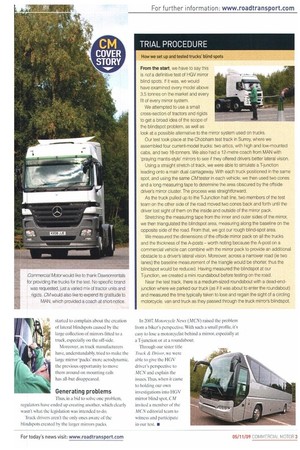TRIAL PROCEDURE
Page 39

If you've noticed an error in this article please click here to report it so we can fix it.
How we set up and tested trucks' blind spots From the start, we have to say this is not a definitive test of HGV mirror blind spots. If it was, we would have examined every model above 3.5 tonnes on the market and every fit of every mirror system.
We attempted to use a small cross-section of tractors and rigids to get a broad idea of the scope of the blindspot problem, as well as look at a possible alternative to the mirror system used on trucks.
Our test took place at the Chobham test track in Surrey, where we assembled four current-model trucks: two arks, with high and low-mounted cabs, and two 18-tanners. We also had a 12-metre coach from MAN with 'praying mantis-style' mirrors to see if they offered drivers better lateral vision.
Using a straight stretch of track, we were able to simulate a T-junction leading onto a main dual carriageway. With each truck positioned in the same spot, and using the same CM tester in each vehicle, we then used two cones and a long measuring tape to determine the area obscured by the offside driver's mirror cluster. The process was straightforward.
As the truck pulled up la the T-Junction halt line, two members of the test team or the other side of the road moved two cones back and forth until the driver lost sight of them on the inside and outside of the mirror pack.
Stretching the measuring tape from the inner and outer sides of the mirror, we then triangulated the blindspot area, measuring along the baseline on the opposite side of the road. From that, we got our rough blind-spot area.
We measured the dimensions of the offside mirror pack on all the trucks and the thickness of the A-posts worth noting because the A-post on a commercial vehicle can combine with the mirror pack to provide an additional obstacle to a driver's lateral vision. Moreover, across a narrower road (ie two lanes) the baseline measurement of the triangle would be shorter, thus the blindspot would be reduced. Raving measured the blindspot at our 1-junction, we created a mint roundabout before testing on the road.
Near the test track, there is a medium-sized roundabout with a dead-endjunction where we parked our truck (as if it was about to enter the roundabout) and measured the time typically taken to lose and regain the sight of a circling motorcycle, van and truck as they passed through the truck mirror's blindspot.
















































































































































